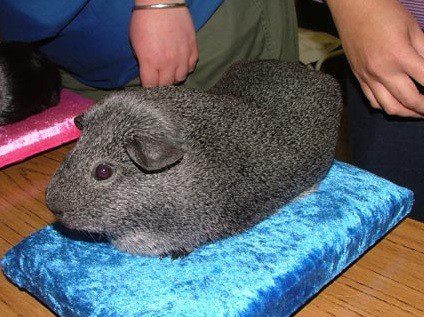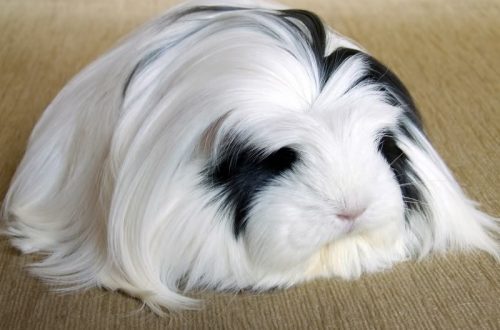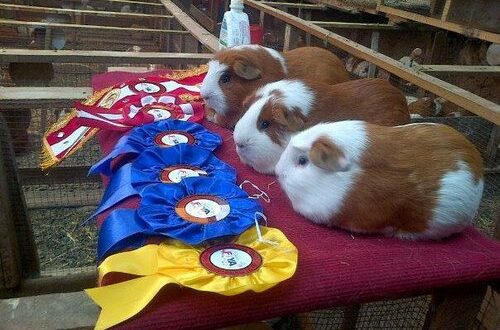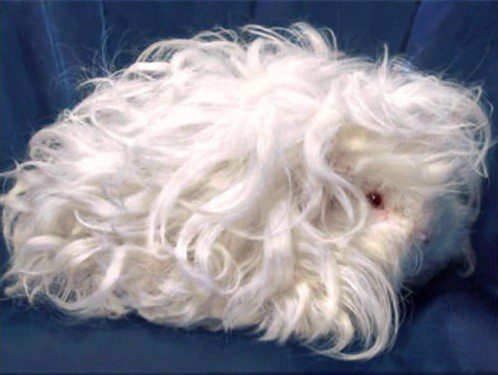
Guinea pig Lunkaria
Lunkaria (Lunkarya Guinea Pig), with an emphasis on “and”, is one of the newest and most recent breeds in the world of guinea pigs.
The appearance of lunkar pigs is very attractive and attracts all eyes. Their main distinguishing feature is tightly twisted spiral curls on long hair, which makes the lunkar look like small sheep.
Lunkaria (Lunkarya Guinea Pig), with an emphasis on “and”, is one of the newest and most recent breeds in the world of guinea pigs.
The appearance of lunkar pigs is very attractive and attracts all eyes. Their main distinguishing feature is tightly twisted spiral curls on long hair, which makes the lunkar look like small sheep.

Contents
From the history of lunkaria
An interesting and, one might say, wonderful story that happened in Sweden in 1986 is connected with the appearance of this breed.
Two sisters, pet store owners in Stockholm, guinea pig breeders and animal lovers, Annika and Monika Lundqvist noticed an unusual male agouti and white pig that was brought to their pet store. The most unusual thing was that the male had unusual curls on his coat, despite the fact that neither of his parents was curly.
As experts in guinea pig breeding, Annika and Monika knew that the “curly” gene is a recessive gene and that a curly pig can only be produced by crossing two curly pigs. Once again, we note that the parents of Prince Adam (as the girls called this miracle pig) were both smooth-haired. Annika and Monika could not help but be interested in this mystery, they took Prince Adam for themselves and crossed him with a Peruvian pig. All newborn babies had the same hard and curly coat as their father.
Everything pointed to the fact that this was some new, hitherto unseen, dominant “curly” gene, although before that all known genes that were responsible for curly hair (in guinea pigs of the Teddy, Texel, Rex breeds) were recessive.
Recall that a dominant gene is a “stronger” gene that ensures the manifestation of one or another trait, regardless of whether the other gene of the same pair is dominant or recessive. A recessive gene, on the contrary, can be suppressed by the influence of a dominant gene. A recessive gene will provide the manifestation of the trait it defines only if it is paired with the corresponding recessive gene. If it is paired with a dominant gene, then it does not appear, since the dominant gene suppresses it.
Then the Lundqvist sisters, for the purity of the experiment, decided to mate the children of Prince Adam with smooth-haired pigs, and being sure that offspring with smooth hair would be born, they were incredibly surprised to see babies again that looked like curly lambs. There was no longer any doubt – it was up to a new gene and, accordingly, a new breed, but it was still far from its recognition. In the meantime, the new gene has been named LuLu, and it has become the fourth “curly” gene known to guinea pig breeders (the first three are the American Teddy gene, the Swiss Teddy gene, and the Rex gene).
If we talk about the nature of the occurrence of this gene, then in all likelihood it appeared as a result of a natural mutation. And he was responsible for a new absolutely unusual type of wool.
The Lundqvist sisters started breeding a new breed. They crossed pigs with the LuLu gene with other breeds (Coronet, Sheltie, etc.) and always all newborn babies had a hard and curly coat. The most beautiful guinea pigs have been crossed with Peruvian guinea pigs. And today it is this combination that is the only recognized option in the breed standards.
When it became clear that we were talking about a new breed of guinea pigs, Annika and Monika had to come up with a name for this breed. The name “lunkaria” was born from a combination of two parts “lunka” (part of the sisters’ surname) and “ria” (from the Swedish word “rya” – a sheep). It is under this name that funny sheep pigs are now conquering the world. In just a couple of years, lunkaria spread throughout Sweden, and then beyond.
The Curly (curly) guinea pig breed is a short-haired variety of Luncaria.
An interesting and, one might say, wonderful story that happened in Sweden in 1986 is connected with the appearance of this breed.
Two sisters, pet store owners in Stockholm, guinea pig breeders and animal lovers, Annika and Monika Lundqvist noticed an unusual male agouti and white pig that was brought to their pet store. The most unusual thing was that the male had unusual curls on his coat, despite the fact that neither of his parents was curly.
As experts in guinea pig breeding, Annika and Monika knew that the “curly” gene is a recessive gene and that a curly pig can only be produced by crossing two curly pigs. Once again, we note that the parents of Prince Adam (as the girls called this miracle pig) were both smooth-haired. Annika and Monika could not help but be interested in this mystery, they took Prince Adam for themselves and crossed him with a Peruvian pig. All newborn babies had the same hard and curly coat as their father.
Everything pointed to the fact that this was some new, hitherto unseen, dominant “curly” gene, although before that all known genes that were responsible for curly hair (in guinea pigs of the Teddy, Texel, Rex breeds) were recessive.
Recall that a dominant gene is a “stronger” gene that ensures the manifestation of one or another trait, regardless of whether the other gene of the same pair is dominant or recessive. A recessive gene, on the contrary, can be suppressed by the influence of a dominant gene. A recessive gene will provide the manifestation of the trait it defines only if it is paired with the corresponding recessive gene. If it is paired with a dominant gene, then it does not appear, since the dominant gene suppresses it.
Then the Lundqvist sisters, for the purity of the experiment, decided to mate the children of Prince Adam with smooth-haired pigs, and being sure that offspring with smooth hair would be born, they were incredibly surprised to see babies again that looked like curly lambs. There was no longer any doubt – it was up to a new gene and, accordingly, a new breed, but it was still far from its recognition. In the meantime, the new gene has been named LuLu, and it has become the fourth “curly” gene known to guinea pig breeders (the first three are the American Teddy gene, the Swiss Teddy gene, and the Rex gene).
If we talk about the nature of the occurrence of this gene, then in all likelihood it appeared as a result of a natural mutation. And he was responsible for a new absolutely unusual type of wool.
The Lundqvist sisters started breeding a new breed. They crossed pigs with the LuLu gene with other breeds (Coronet, Sheltie, etc.) and always all newborn babies had a hard and curly coat. The most beautiful guinea pigs have been crossed with Peruvian guinea pigs. And today it is this combination that is the only recognized option in the breed standards.
When it became clear that we were talking about a new breed of guinea pigs, Annika and Monika had to come up with a name for this breed. The name “lunkaria” was born from a combination of two parts “lunka” (part of the sisters’ surname) and “ria” (from the Swedish word “rya” – a sheep). It is under this name that funny sheep pigs are now conquering the world. In just a couple of years, lunkaria spread throughout Sweden, and then beyond.
The Curly (curly) guinea pig breed is a short-haired variety of Luncaria.
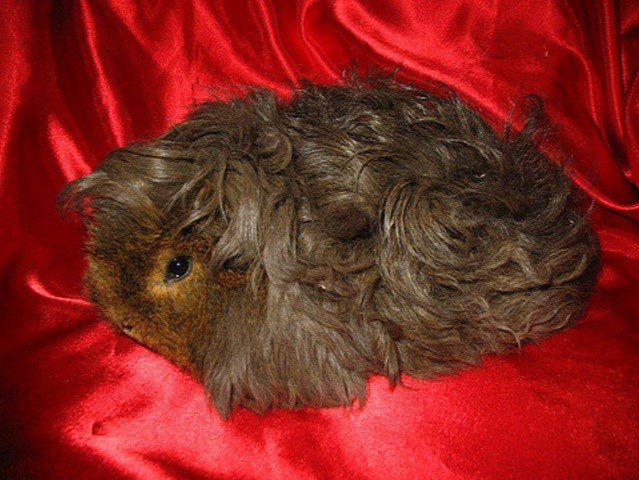
Lunkar features
So, as mentioned above, the most important feature of the luncaria is a hard, long fur, twisted into steep corkscrew-shaped curls, and these curls do not straighten out with frequent combing, like a texel or alpaca, but stubbornly fold back and keep their shape perfectly. Thanks to this feature, Luncaria is quite easy to care for, despite the fact that this breed belongs to the long-haired, which means demanding care breeds. The special shape of the hair prevents debris from clinging to the fur and getting stuck in it, so even after walking through the hay in the cage, the lunkaria pig will remain clean.
Newborn baby lunkarii are very similar to newborn texels or alpacas, but then the hair begins to grow rapidly and twist into steep curls, which at first stick out in all directions, giving the babies a very comical look.
And on the muzzle, on the contrary, the hair begins to fall out, and according to experienced breeders, the more hair falls from the muzzle, the coarser the fur will be. With regard to lunkaria, the rule applies: the coarser the fur, the better!
To maintain the purity of the breed, it is not recommended to cross Lunkari pigs with Texel, Merino, Alpaca breeds, with smooth-haired breeds, as well as with pigs carrying the Rex or Teddy gene. The offspring from such crosses will have a softer and thinner coat, atypical for true lunaria. Offspring born from such crosses will not be considered purebred. At shows, guinea pigs born from a pair of Lungaria + Sheltie, Lungaria + Peruvian or Lunkaria + Coronet are allowed, but are judged accordingly.
At the same time, when properly bred, children often even surpass their parents in the quality of wool and have a rough and hard coat, as required by the standards.
An experienced breeder will determine a real, high-quality lunkaria right from birth: the baby will have hard, well-defined curls on the coat. Over time, the hair will become coarser, thicker and begin to stick out in all directions. Wool in lunkaria, like other guinea pigs, grows throughout life, 2-2,5 cm per month. Until 5-6 months of age, the coat will stick out in all directions, giving the pig a very funny look, and then, under the influence of gravity, it will begin to fall down. It is from this age that the breeder will have to decide for himself whether he will grow the coat or cut his pet to a comfortable length.
Lunkar has very thick and dense skin, which helps to support the weight of heavy wool.
As far as colors are concerned, Luncarii can be any color or any combination of colors.
Lunkariya has two sockets for groats. There should be no parting along the spine. The abdomen should also have tight curls. In spring and autumn, the Lunkaria begins a molting period, the hair falls out and is renewed, and the new hair grows quite quickly.
So, as mentioned above, the most important feature of the luncaria is a hard, long fur, twisted into steep corkscrew-shaped curls, and these curls do not straighten out with frequent combing, like a texel or alpaca, but stubbornly fold back and keep their shape perfectly. Thanks to this feature, Luncaria is quite easy to care for, despite the fact that this breed belongs to the long-haired, which means demanding care breeds. The special shape of the hair prevents debris from clinging to the fur and getting stuck in it, so even after walking through the hay in the cage, the lunkaria pig will remain clean.
Newborn baby lunkarii are very similar to newborn texels or alpacas, but then the hair begins to grow rapidly and twist into steep curls, which at first stick out in all directions, giving the babies a very comical look.
And on the muzzle, on the contrary, the hair begins to fall out, and according to experienced breeders, the more hair falls from the muzzle, the coarser the fur will be. With regard to lunkaria, the rule applies: the coarser the fur, the better!
To maintain the purity of the breed, it is not recommended to cross Lunkari pigs with Texel, Merino, Alpaca breeds, with smooth-haired breeds, as well as with pigs carrying the Rex or Teddy gene. The offspring from such crosses will have a softer and thinner coat, atypical for true lunaria. Offspring born from such crosses will not be considered purebred. At shows, guinea pigs born from a pair of Lungaria + Sheltie, Lungaria + Peruvian or Lunkaria + Coronet are allowed, but are judged accordingly.
At the same time, when properly bred, children often even surpass their parents in the quality of wool and have a rough and hard coat, as required by the standards.
An experienced breeder will determine a real, high-quality lunkaria right from birth: the baby will have hard, well-defined curls on the coat. Over time, the hair will become coarser, thicker and begin to stick out in all directions. Wool in lunkaria, like other guinea pigs, grows throughout life, 2-2,5 cm per month. Until 5-6 months of age, the coat will stick out in all directions, giving the pig a very funny look, and then, under the influence of gravity, it will begin to fall down. It is from this age that the breeder will have to decide for himself whether he will grow the coat or cut his pet to a comfortable length.
Lunkar has very thick and dense skin, which helps to support the weight of heavy wool.
As far as colors are concerned, Luncarii can be any color or any combination of colors.
Lunkariya has two sockets for groats. There should be no parting along the spine. The abdomen should also have tight curls. In spring and autumn, the Lunkaria begins a molting period, the hair falls out and is renewed, and the new hair grows quite quickly.
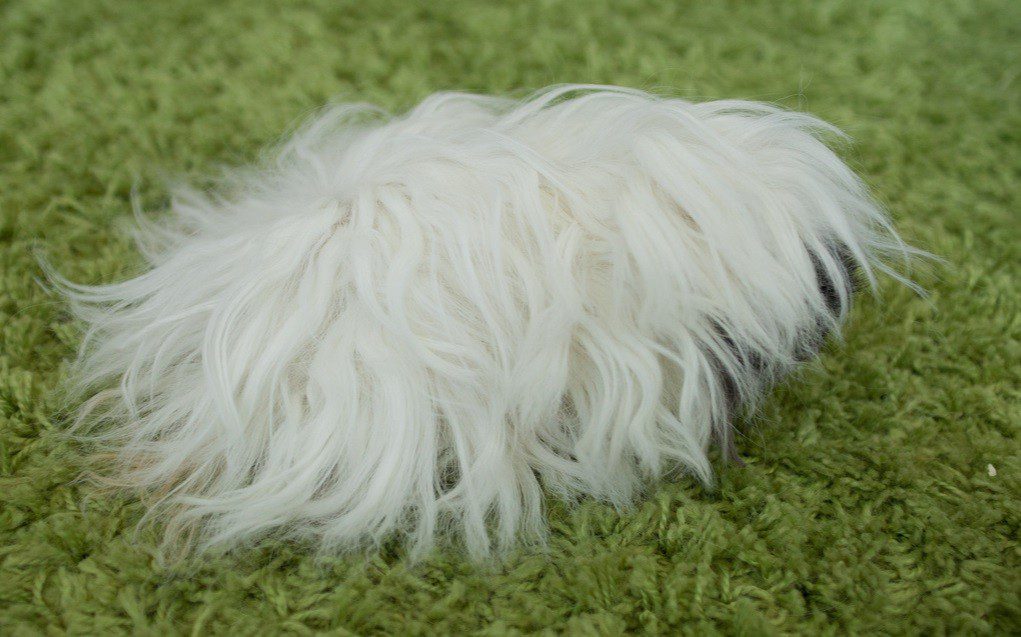
Maintenance and care
The basic rules for keeping lunkaria are no different from the rules for keeping all guinea pigs: a spacious cage, proper nutrition and love and care without fail.
The only feature of lunkaria is their intolerance to high temperatures due to increased “fluffiness”. On hot days, air conditioning can be a life saver for luncaria. Also consider this feature when releasing your pet outside in the summer. No direct sun! Only shade and partial shade! Lunkaria is more susceptible to heatstroke than other breeds of guinea pigs.
The basic rules for keeping lunkaria are no different from the rules for keeping all guinea pigs: a spacious cage, proper nutrition and love and care without fail.
The only feature of lunkaria is their intolerance to high temperatures due to increased “fluffiness”. On hot days, air conditioning can be a life saver for luncaria. Also consider this feature when releasing your pet outside in the summer. No direct sun! Only shade and partial shade! Lunkaria is more susceptible to heatstroke than other breeds of guinea pigs.
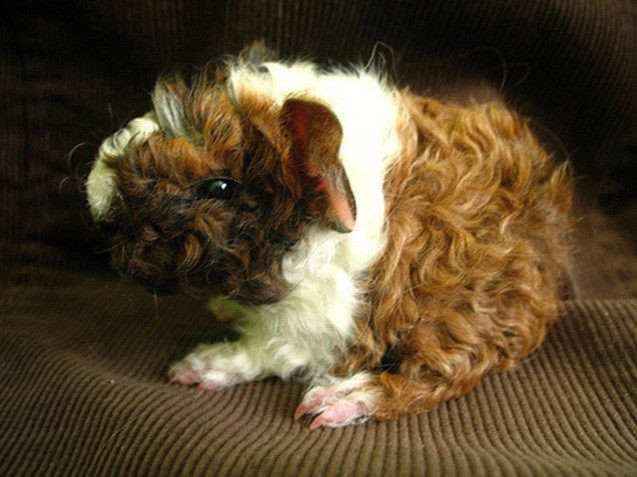
Lunaria hair care
While Lunaria will be much easier to care for than other long-haired guinea pigs due to their special coat structure, you still need to comb and brush your pet at least occasionally. This will require a wide toothed comb or a special afro comb.
A simple experiment to check whether or not you are caring for a lunkar coat is to run your fingers deep into the coat and “comb” it. If the fingers slide easily, there are no tangles or knots, then everything is in perfect order.
Experts say Lunaria need bathing every 6-8 weeks to maintain healthy skin and a clean coat.
While Lunaria will be much easier to care for than other long-haired guinea pigs due to their special coat structure, you still need to comb and brush your pet at least occasionally. This will require a wide toothed comb or a special afro comb.
A simple experiment to check whether or not you are caring for a lunkar coat is to run your fingers deep into the coat and “comb” it. If the fingers slide easily, there are no tangles or knots, then everything is in perfect order.
Experts say Lunaria need bathing every 6-8 weeks to maintain healthy skin and a clean coat.
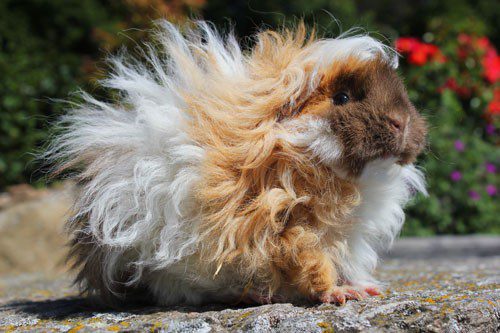
The nature of the lunkaria
Lunkariya is a very funny and curious breed. These pigs are friendly, calm and sociable. They love people, easily allow themselves to be stroked and picked up. Good contact with children.
Lunkariya is a very funny and curious breed. These pigs are friendly, calm and sociable. They love people, easily allow themselves to be stroked and picked up. Good contact with children.



